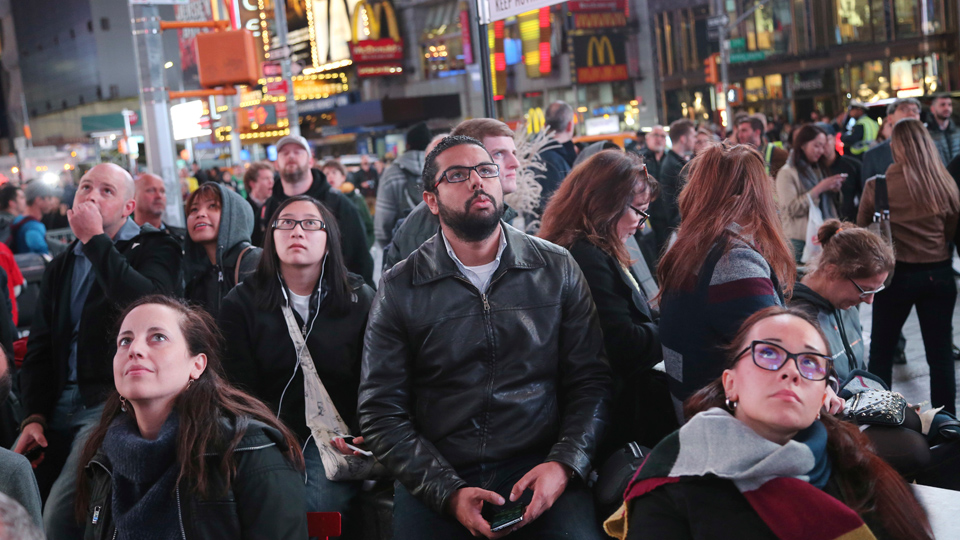
WASHINGTON – Worker organizers and progressive activists across the country are already mapping out strategies for responding to the election yesterday of Donald Trump as President of the United States.
The billionaire scam artist was able to gain the support of right wingers who already control the U.S. House and Senate, most states and many courts, by truthfully assuring them he will continue and strengthen anti-worker policies that enrich the already wealthy.
At the same time, he used lies, fear-mongering and scapegoating to gain the support of many of the victims of those policies.
Trump was put over the top by winning some 60 percent of the votes cast by white working class voters and 27 percent of the votes cast by Latinos, a higher percentage than had voted for Mitt Romney.
All exit polls showed that voters who supported Bernie Sanders in the Democratic primary turned out in full force to vote for Clinton, while only 0.9 of the electorate supported the Green Party, not enough to make a difference. The Libertarian Party captured 3.3 percent of the vote, which most observers agree would have otherwise gone to Trump.
Members of the millennial generation voted 2 to 1 for Clinton, but fewer of them than expected cast ballots.
About 40 percent of Trump voters have college degrees.
Voter suppression laws newly minted in states controlled by Republicans played a role in Trump’s victory. And last minute anti-Clinton dirty tricks played by FBI Director James Comey led some would-be Clinton voters to switch to Trump and some Republicans who opposed Trump to come home to him in the early voting period.
However, the vast majority of voters supporting Trump said they voted for him because he would “shake up the establishment.” At the same time, some 61 percent of voters said they were aware Trump was not qualified to be President.
Many said they had been Obama Democrats, but that they now feel their party has “abandoned” them. They pointed to the fact that their standard of living has plummeted and that they no longer enjoy the economic security they once had. They said they felt “angry and frustrated” with the government and “wanted a change.”
As liberal columnist E.J. Dionne wrote in the Washington Post, “The massive support for Trump among white working-class voters suggests that they do not find the economic promises of progressive politicians sufficiently persuasive or believable to entice them away from the riskiest vote they will ever cast in their lives.”
Ironically, a poll done by YouGov/Economist found that 80 percent of Trump supporters listed “too much money in politics” as a cause of their being “ignored” by the government.. They said they supported Trump because they believed him when he said “I’m so rich I can’t be bought off.”
In exit polls conducted in upper Midwest states that have suffered from de-industrialization, some one half of voters identifying themselves as union members said they voted for Trump. The AFL-CIO issued a statement in September saying that about 30 percent of union members in battleground states were Trump supporters.
Trump was able to manipulate the anger and anxiety of many workers in the so-called “rust belt” by echoing their belief that they had lost jobs because the NAFTA trade agreement had encouraged employers to move operations overseas. He continuously reminded them that as First Lady, Clinton had campaigned for the passage of NAFTA.
In fact, NAFTA was passed over the objection of the majority of Democrats serving at that time in the House and Senate.
During his campaign, while promising to “bring back to America” jobs lost to NAFTA and other trade agreements, Trump never described a plan for doing so. Instead, he incited racism and xenophobia by blaming on immigrants many of American’s economic woes.
Similarly, he never presented a plan for fighting the world-wide threat of terrorism but did try to scapegoat all Muslims.
Trump’s campaign was run by Steve Bannon, a leader of the so-called “alt-right” fringe.
Trump’s victory mirrors the victories of xenophobic right-wing leaders in many nations of Europe. For example, those supporting Britain leaving the European Union were able to win the “Brexit” election because they had gained the support of unemployed and underemployed British workers living in the de-industrialized central part of England. The economic landscape there looks very much like what can be seen all over the Rust Belt states.
The measure of how successful Trump was in putting together a coalition of working people, pro-billionaire right wingers and relatively affluent middle class voters is that his candidacy helped most Republicans in the House and Senate retain their seats.
As of midnight last night Democrats had gained only five seats in the U.S. House.
In the Senate races they had won two seats, one in Nevada and one in Illinois.
Political observers are saying that Clinton underestimated how divided the nation has become. She geared her campaign toward attracting “moderates” although the number of voters identifying themselves with that label has greatly decreased since the last presidential election.
The fact that the U.S. is so divided presents an opportunity for worker advocates and progressive organizers. The fact is, almost half of the voters did not vote for Trump yesterday. Furthermore, many working people who did vote for him say they will now hold him strictly accountable for making good on his promises.
At a forum sponsored by Working America a few months ago, Damon Silvers, the AFL-CIO’s policy director, said that the battle against the right wing “won’t be won on television or on the Internet. It will be won through organizing working people, face to face.”
He stressed that the union movement must promote real solutions to the real problems faced by many American workers of all races and ethnic groups. It must “become an alternative to Trumpism.”
Throughout this past year, millions of Americans have aligned themselves with movements to bring to life the platform adopted by the Democratic Party, which aims to “make our government work for all of us, not just those at the top.” This includes, among other things, taking further steps toward universal health care, raising the minimum wage, addressing climate change, passing comprehensive immigration reform, making our criminal justice system more just, making college affordable for all, protecting a woman’s right to control her own health care and protecting the rights of the LGBTQ community.
Ballot initiatives that called for wage increases, family leave and ending the horrific effects of Citizens United did well yesterday.
Now that Trump has won the White House and Republicans control all branches of the federal government, the importance to Americans who seek a more equitable society of building a powerful people’s movement is more critical than ever.










